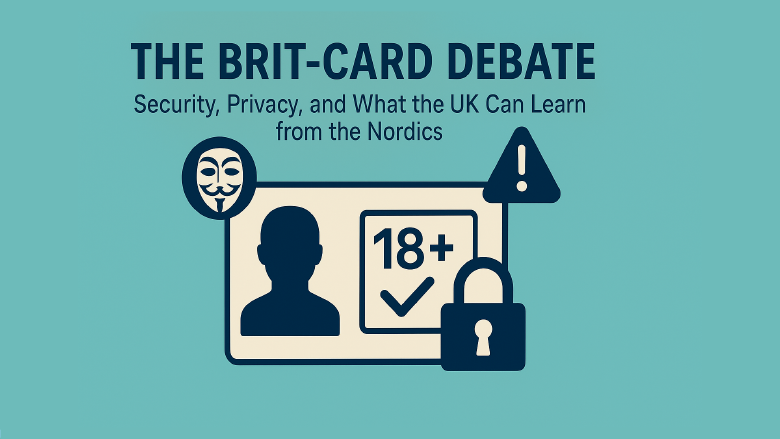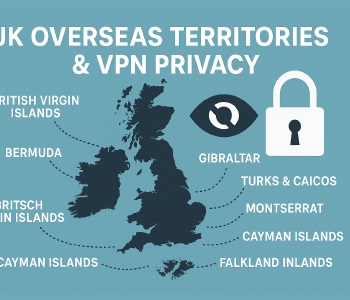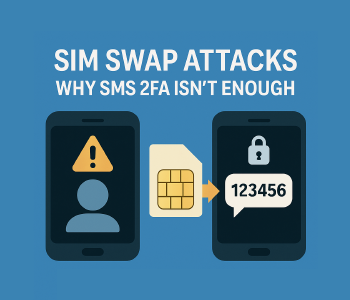
The Brit-Card Debate: Security, Privacy, and What the UK Can Learn from the Nordics
The UK government’s latest plan for a mandatory digital ID — quickly nicknamed the “Brit-Card” to the chargin of the Scots, Welsh and Northern Irish — is sparking a heated debate. Supporters promise faster logins, fewer frauds, and lower costs. Critics see a mass-surveillance tool wrapped in slick digital branding.
So which is it? Let’s break it down — risks first, then potential upsides, and finally why the UK context makes this especially thorny.
Security Risks: One Database to Rule Them All
Digital ID schemes always raise the same red flag: centralised data = a massive target.
Imagine a single government database holding your name, address, biometrics, and work history. That’s not just useful to service providers — it’s irresistible to hackers. Privacy groups call it “a juicy target” because one breach could expose millions at once.
Other top concerns:
- Cloud dependence: Handing sensitive data to Amazon, Google, or similar providers means their breach could become your breach.
- Misuse and leaks: Two-thirds of Britons worry their data could be sold or used without consent. Insider abuse and accidental leaks are very real.
- Mass surveillance: Linking IDs across jobs, healthcare, travel, and housing gives the state unprecedented visibility into everyday life.
- Exclusion: Around 10–15% of UK households lack a smartphone. Without strong non-digital alternatives, they risk being locked out of essential services.
- History repeating: The last UK ID-card plan collapsed in the 2000s after fierce public backlash. Skepticism runs deep.
For more context on how national surveillance frameworks overlap with digital IDs, see our guide on VPN jurisdiction and the Five Eyes alliance.
What About People Without Smartphones?
The plan assumes most people will carry their Brit-Card in an app. But not everyone can (or wants to) do that.
Without careful design, whole groups — elderly, disabled, low-income, or simply tech-resistant — could be excluded. Workarounds exist, but each adds cost and complexity:
- Physical cards or paper certificates as official alternatives
- Public kiosks in libraries or post offices for updates and temporary codes
- SMS or voice one-time passwords for authentication (though these come with security risks)
- Legal safeguards to ensure passports and driving licences remain valid everywhere
The bottom line: if digital ID is mandatory, non-digital fallbacks must be equally valid — or else inequality grows. You can read more about exclusion risks in our broader privacy guide.
Lessons from the Nordics: What Works Well
Supporters point to Sweden, Norway, and Finland, where digital IDs are practically universal. And it’s true — the benefits are real. The table below shows how a nationwide ID can deliver real value when designed well:
| Area | Typical Benefit of a Digital ID | How the Nordic Experience Illustrates It |
|---|---|---|
| Instant, trusted identity proof | A cryptographically signed credential verified in milliseconds, eliminating the need to carry multiple documents. | Sweden’s BankID (used by >95% of adults) lets people log into banks, government portals, health services, and even sign contracts with a tap. |
| Reduced fraud and impersonation | Centralised, tamper-proof records make it harder to forge IDs or create fake profiles. | Finland’s Suomi.fi links population and tax registries to one digital profile, cutting down on costly manual checks. |
| Simplified onboarding for services | One-click registration across banking, telecom, utilities, rentals, and more. | Norway’s ID-Porten provides a single sign-on for over 150 public services, also used by private companies. |
| Cross-border interoperability | Recognised in neighbouring countries, easing travel and EU-wide services. | The Nordic e-ID framework (eIDAS-compatible) lets a Swedish BankID holder authenticate on Danish or Icelandic portals. |
| Lower administrative costs | Savings on printing, mailing, and verification. | Denmark’s NemID (replaced by MitID) saved the public sector an estimated €50m annually. |
| Improved accessibility for vulnerable groups | Can be issued free and linked to existing registries for those lacking traditional documents. | Estonia issues free e-Residency cards, giving anyone with verified identity access to banking and business services. |
| Enhanced data security & auditability | Every access logged cryptographically, creating transparency. | Finland’s Suomi.fi records each authentication event, viewable by citizens. |
| Facilitates new digital services | Enables e-voting, e-signatures, tax automation, and digital healthcare. | Sweden’s BankID underpins e-prescriptions, allowing instant, app-based prescription fulfilment. |
But here’s the catch: Nordic success relied on strong laws, high digital literacy, and years of public trust-building. Without that, adoption in the UK could stumble.
Key Take-aways for a UK-wide “Brit-Card”
- Speed & convenience – Citizens could prove who they are in seconds, whether they’re opening a bank account, applying for a job, or accessing NHS services.
- Cost savings – Both the public sector and private businesses stand to reduce paperwork, postage, and manual verification expenses.
- Fraud reduction – A centrally verified, tamper-proof credential makes identity theft considerably harder than with forged passports or driver’s licences.
- Interoperability – If built to eIDAS standards, the UK ID could be recognised across the EU and the wider Nordic region, simplifying travel and cross-border work.
- Inclusivity (if designed correctly) – By issuing a free physical token or paper backup for those without smartphones, the system can reach people who are currently “digitally invisible.”
Caveats – Why the Nordic success stories matter
- Robust legal framework – The Nordic states paired their technical solutions with strong data-protection laws and independent oversight bodies. Replicating the benefits in the UK would require equally rigorous safeguards.
- High digital literacy & broadband coverage – Adoption rates are high because most citizens already use smartphones and have reliable internet. The UK would need complementary programs (subsidised devices, public kiosks) to avoid the exclusion risks highlighted earlier.
- Public trust – Trust was earned over years of transparent operation (e.g., clear audit logs, easy opt-out mechanisms). Any new UK scheme must invest heavily in communication and accountability to gain similar confidence.
What Privacy Advocates Are Saying
Civil-liberties groups haven’t minced words:
- “Dangerous implications for rights and freedoms” — Liberty and Big Brother Watch
- “An enormous hacking target” — The Guardian’s take on centralised data
- “Unlikely to stop illegal work or immigration” — multiple groups argue the claimed benefits don’t outweigh the risks
They also warn about mission creep: once such a system exists, pressure grows to expand its use — from health records to policing to financial tracking. That same concern often arises in debates about data retention and no-log policies.
The Five Eyes Angle: Why the UK Debate Is Different
The UK isn’t operating in a vacuum. As a core member of the Five Eyes intelligence alliance (with the U.S., Canada, Australia, and New Zealand), its citizens already live under some of the world’s broadest surveillance powers.
Key differences in this context:
- Data sharing culture: Five Eyes allies routinely exchange intelligence. A Brit-Card could expand what’s on offer.
- Legal constraints: Unlike the U.S., the UK must meet GDPR-style adequacy rules — a strong lever for privacy advocates.
- Public memory: The last ID-card plan failed spectacularly; trust is already thin.
- Surveillance laws: The UK’s Investigatory Powers Act (“Snooper’s Charter”) makes critics wary of adding yet another surveillance layer.
For a comparison, see how similar intelligence-sharing concerns play out in discussions of Tor network security.
Final Thought: Risk Multiplier or Digital Leap?
Digital ID isn’t inherently bad. In the right framework, it can make life simpler, cheaper, and more secure. But in the wrong hands, it’s a privacy-risk multiplier — one that expands state power while excluding those already on society’s margins.
For the Brit-Card to succeed, it would need:
- Independent oversight and strict limits on data sharing (especially abroad)
- Strong non-digital alternatives with equal legal weight
- Transparent governance, including user-facing audit logs
- A clear, narrow scope — with guarantees it won’t expand unchecked
The UK can learn from the Nordics — but it also has to confront its own unique surveillance history and legal landscape. Without that, the Brit-Card risks repeating the past instead of building the future.
For more on how identity systems intersect with digital security, see our guide on KYC and identity-based risks.





